.webp?2025-12-17T15:00:29.367Z)
Spotify Wrapped ideas make stats lovable
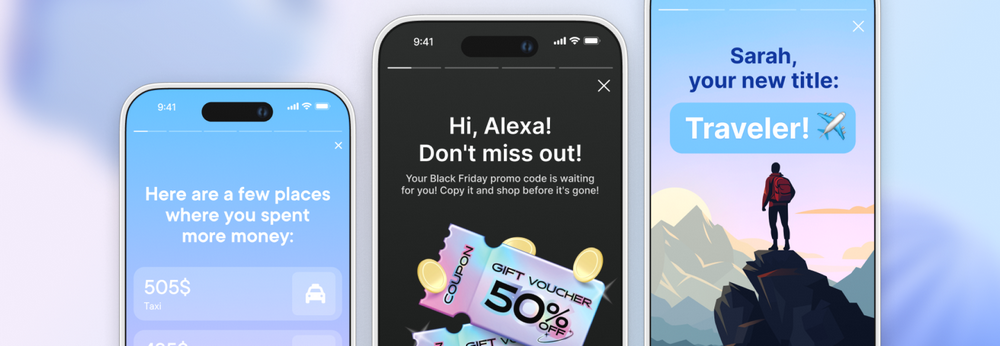
Personalized Shopping Experience
Karina
Author @ InAppStory
Have you ever wondered why shopping online can feel so… impersonal? You scroll through countless pages, trying to find what you need, but it’s exhausting. Compare that to the rare experience of visiting a site where everything feels not creepy, but in a way that makes you think, Wow, they get me. The homepage highlights tools and products directly related to your industry. Your previous searches? Factored in. Items you were comparing last week? Now part of a tailored bundle offer. The process feels smooth, intuitive, effortless.
It’s personalized shopping experience and it’s reshaping how businesses connect with customers. Done right, it builds trust, keeps customers coming back, and drives sales. In fact, according to Accenture, 91% of customers are more likely to buy from brands that offer tailored experiences.
Still, personalization isn’t as simple as throwing out recommendations based on browsing history. Customers are smart. They know when they’re being tracked, and if your strategy feels lazy or invasive, they’ll walk away. So how do you personalize thoughtfully? How do you make it feel seamless and not awkward? That’s what we’ll unpack here.
By the end of this article, you’ll understand:
- What personalized shopping experience really is (and what it isn’t).
- Why it matters more than ever, especially in a world where everyone’s attention span is measured in seconds.
- Specific strategies you can implement whether you’re running a small online store or managing an enterprise-level ecommerce platform.
What is Ecommerce Personalization?
Let’s break it down in simple terms: Ecommerce personalization means tailoring the online shopping experience to the individual customer. It’s about using data to show people what they want before they know they want it. It’s smart, responsive, and, when done right, feels completely natural.
Website Personalization: Making Your Store Smarter
Think about it like this: your website is your storefront. But unlike a physical store, you don’t have employees greeting people at the door or helping them find what they need. Website personalization fills that gap by making your site do the heavy lifting.
Here’s an example: Netflix’s recommendation algorithm. It doesn’t just guess what you want to watch. It analyzes what you’ve watched, how long you spent watching it, and what other people with similar preferences enjoyed. The result? No two users see the same interface. It’s hyper-personalized and built entirely on data-driven insights. Netflix guides you to content you didn’t even know you wanted.
Ecommerce sites use the same principles. Think of Amazon’s “frequently bought together” feature. It’s not just there to upsell; it’s carefully crafted to anticipate needs. If you’re buying a camera, Amazon might suggest memory cards or a tripod. Its goal is to make your life easier.
And this isn’t just a big-business game. Tools like Dynamic Yield or Nosto allow smaller ecommerce sites to implement similar, real-time personalization, so even boutique stores can act like ecommerce giants.
Customer Personalization: Building Loyalty, Not Just Sales
But let’s take it further. Personalization doesn’t stop at the website. It extends into how you interact with customers over time. This is where customer personalization comes in. It’s about making people feel like more than just a transaction.
Take Nike’s membership program. It pays attention to how you use their products. If you sync your workouts through the Nike app, it might recommend training programs tailored to your goals. It even notifies you about product drops it knows you’ll be interested in. Nike isn’t just selling shoes; it’s becoming part of your daily routine. That’s personalization that creates loyalty.
Another example? Spotify Wrapped. Every December, Spotify sends users a custom report showing their top songs, artists, and genres from the year. It’s not just fun — it’s shareable. And it’s why Spotify feels less like a faceless tech company and more like a trusted part of your life.
Here’s the exciting part: you don’t have to be Spotify to offer something like this. Mobile apps across industries can deliver similar personalized recaps using tools like InAppStory. Imagine showcasing your users’ activity — weekly, monthly, or yearly — directly within your app. It’s not just a summary of stats; it’s a way to celebrate their personal highlights. Whether it’s fitness milestones, learning achievements, or shopping habits, these stories make users feel valued and connected.
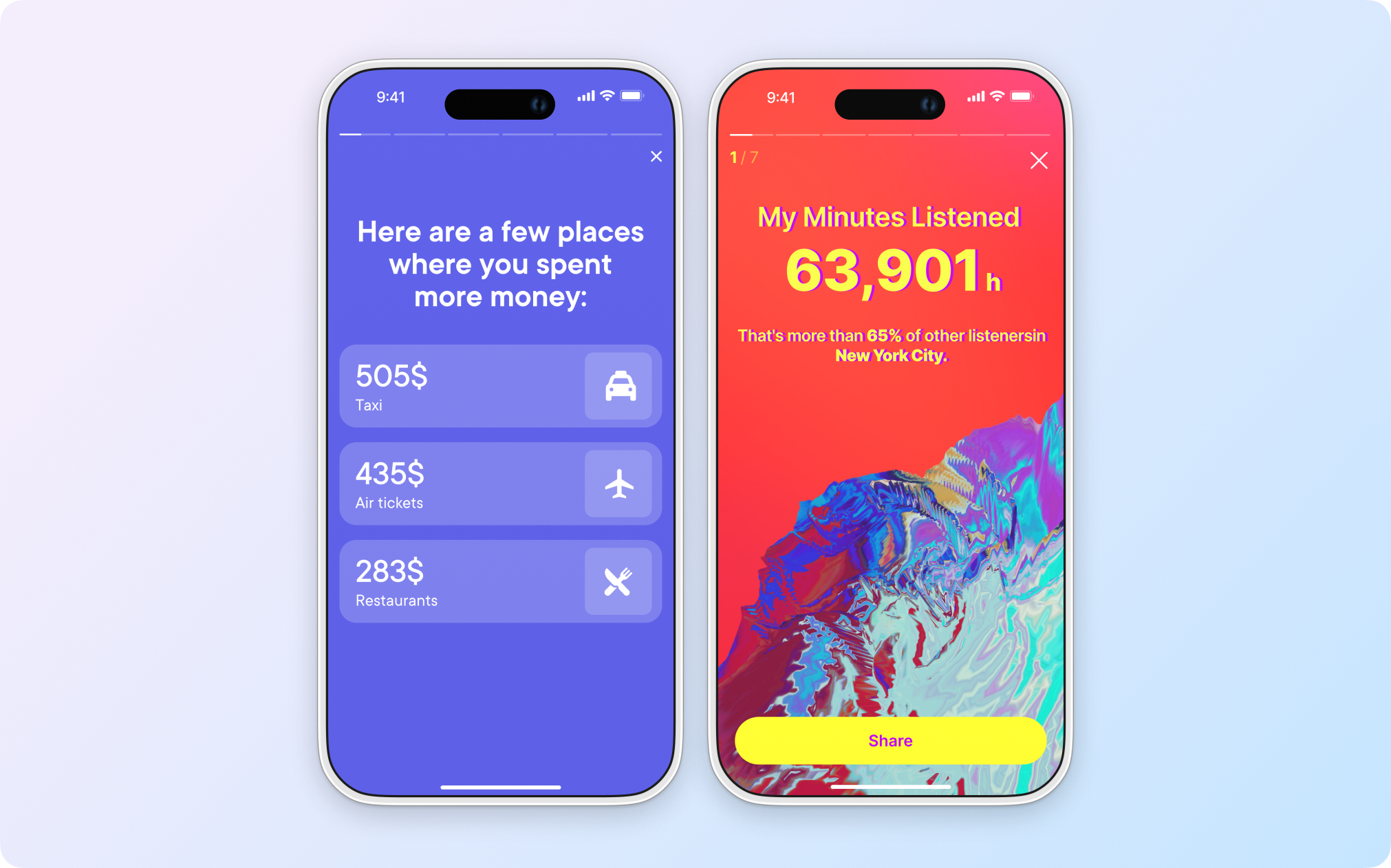
Why Does Personalization Work?
Here’s the thing: people crave simplicity. Online shopping can be overwhelming, with thousands of products and endless options. Personalization says, Here’s what you’re looking for. No guesswork, no hassle.
But there’s more to it. Personalization also builds trust. When customers feel like you “get” them, they’re more likely to stick around. A Smart Insights report found that 63% of customers will stop buying from brands that don’t personalize effectively. That’s a problem. But for businesses willing to do it right, it’s also an opportunity.
Of course, personalization comes with challenges. Customers are increasingly wary of how their data is used. If your strategy feels intrusive like when ads seem to follow you around after one quick search,it can backfire. Transparency is key here. Customers don’t mind giving you their data if you’re upfront about why you need it and how it’ll improve their experience.
Why Ecommerce Personalization is Important
Consider this: A report by McKinsey found that companies excelling at personalization can see a 20% increase in customer satisfaction, a 10-15% boost in revenue, and 30% higher marketing ROI. Let’s look at three ways personalization moves the needle for ecommerce and where the risks and rewards intersect.
1. Loyalty: Building Emotional Connections, Not Just Transactions
What makes a customer loyal? Loyalty happens when customers feel understood, when a brand shows, “We see you, and we know what you care about.” Personalization is how you move from a transactional relationship to an emotional connection.
Here’s a standout example: Starbucks’ app. Most people think of it as a loyalty program, but it’s much more than that. Starbucks tracks every purchase not just to log stars but to personalize the customer experience. If you’re a regular latte drinker, the app might encourage you to “Try a cold brew and earn double stars today.” Or it might reward you for buying three drinks in a week with a surprise freebie.
This gamification doesn’t feel pushy; it feels fun. Why? Because it’s rooted in personalized engagement. Starbucks is creating moments.
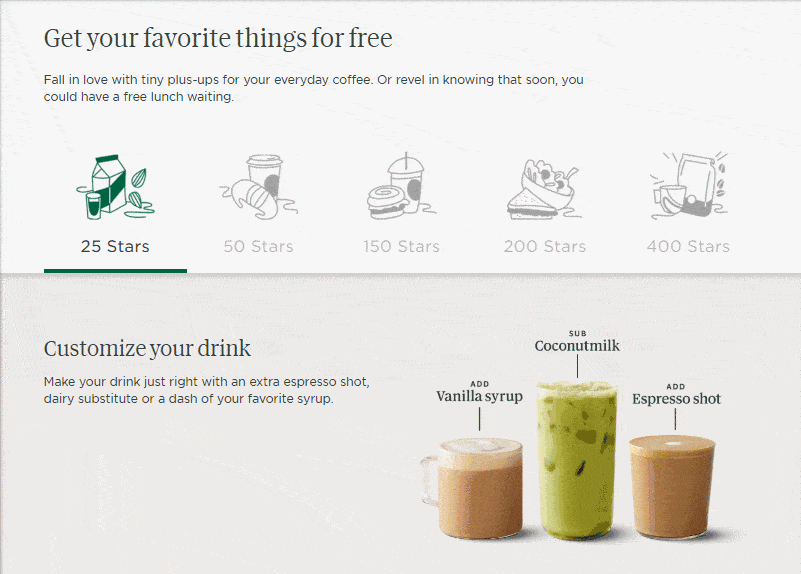
Similar to Starbucks, Dodo Pizza’s campaign transformed a traditional advent calendar mechanic into an interactive, emotionally engaging experience that connected with users. By combining daily offers with personalized, shareable content, the game achieved impressive user engagement, social sharing, and brand loyalty.
Gamification helps e-commerce brands differentiate through engaging, interactive experiences that encourage ongoing interaction and brand loyalty.
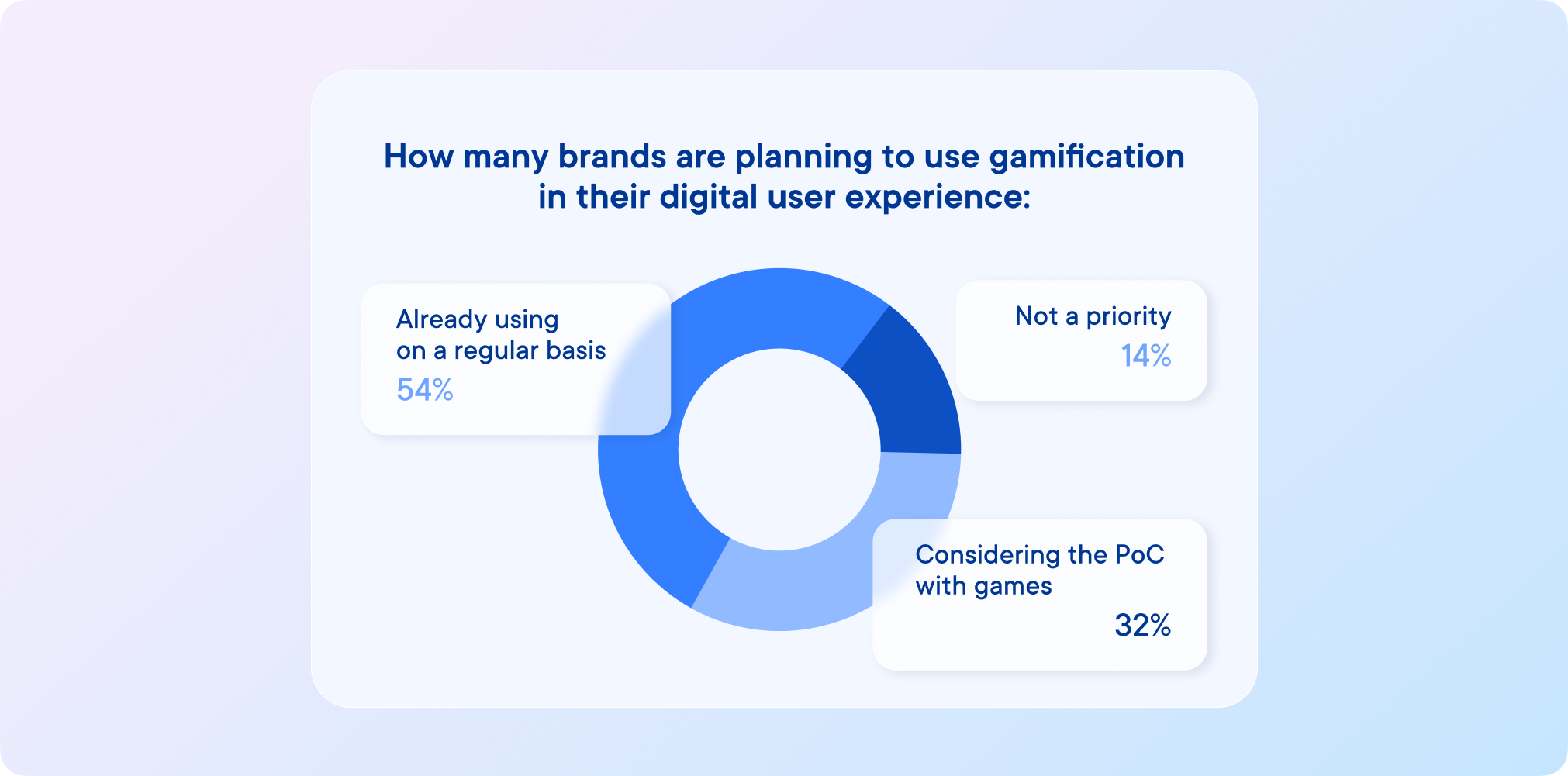
When gamification is used:
● To promote digital ordering
● To motivate users come back to the app more frequently
● To promote loyalty program and its benefits
● To feature product offering from premium providers
InAppStory offers pre-built mini-games for instant marketing success of your app. Incorporate them in your mobile app to see how game mechanics drives customer retention and brand loyalty:
2. Conversions: Helping Customers Cut Through the Noise
Have you ever closed a shopping tab out of sheer overwhelm? Too many options, not enough time. That’s the reality for most ecommerce customers today. Personalization tackles this head-on by guiding customers to the products they actually want or, sometimes, the ones they didn’t know they needed.
But not every brand nails this. Irrelevant recommendations are a trust killer. Imagine shopping for a valentine’s day gift and being bombarded with ads for the same item for weeks. It doesn’t feel smart; it feels lazy. Personalization should make customers’ lives easier, not annoy them. Smart brands use personalization to anticipate needs, not just push products.
3. Competitive Edge: Winning Where the Giants Can’t
Ecommerce isn’t a fair fight. Giants like Amazon dominate with their endless inventories and same-day shipping. So how can smaller brands stand out? The answer isn’t to try to out-scale them. It’s to do what they can’t: create highly personalized, niche-focused experiences.
However, here’s the challenge: scaling personalization responsibly. For smaller brands, investing in advanced personalization tools can feel overwhelming. The key is to start small and prioritize the areas that have the most impact. For example:
- Personalized email campaigns that segment customers based on their preferences.
- Dynamic homepage layouts that adjust to browsing behavior.
- Post-purchase recommendations that encourage repeat purchases.
It’s not about doing everything at once. It’s about choosing the right moments to make your customers feel seen.
Types of Ecommerce Personalization
Everyone in ecommerce knows personalization is important but where do you actually begin? You can’t overhaul your entire system overnight, and not every tactic will work for every business.
Personalization isn’t perfect. It has its challenges: scalability, privacy concerns, and the risk of overstepping. Let’s explore 11 types of personalization, not just to show you what’s possible but to also weigh the pros and cons.
Strategy 1. Personalized Homepage Experiences
The homepage is where it all begins. But does it really need to look the same for everyone? Probably not. For returning customers, personalization might mean reordering the layout to highlight what’s most relevant to them whether it’s categories they frequently shop in or products they’ve viewed before.
However, here’s the challenge: balancing first impressions with personalization. You don’t want to confuse new visitors with hyper-specific layouts that assume too much about their preferences. For returning users, though, it can create a sense of familiarity that keeps them engaged.
Pro: A personalized homepage makes users feel seen and simplifies their navigation.
Con: For smaller businesses, implementing real-time changes can be costly and technically demanding.
Strategy 2. Customized Product Recommendations
Here’s the thing about recommendations: done well, they’re incredibly helpful. Done poorly, they’re just noise. Good product recommendations work because they reduce the mental load of decision-making. You’re not forcing someone to browse through hundreds of items you’re suggesting things they might actually want based on their behavior.
The downside? Recommendations can sometimes miss the mark. Ever seen a suggestion for something you already bought? Annoying, right? Plus, customers know when a recommendation feels forced, which can make your brand seem disorganized.
Pro: Saves customers time and increases the likelihood of upsells.
Con: Requires accurate data and constant fine-tuning, which can be resource-intensive.
Strategy 3. Location-Based Personalization
Let’s face it: where someone shops from matters. Someone in New York in December probably doesn’t want to see swimwear, while someone in Sydney might be looking for it year-round. Personalization based on location allows you to show relevant products, currencies, and even shipping options.
Pro: Makes content more relevant and tailored to local contexts.
Con: Risks alienating users who want broader options or don’t want their location tracked.
Strategy 4. Real-Time Cart Personalization
You’ve probably heard this one: most carts are abandoned before checkout. Personalization can help nudge hesitant shoppers over the finish line. Think dynamic discounts based on cart value or tailored cross-sell recommendations like, “You might also need this charger for your laptop.”
But it’s a fine line. Overloading the cart with suggestions or popping up irrelevant offers can overwhelm the customer and have the opposite effect. The key here is subtlety.
Pro: Boosts cart value and reduces abandonment rates.
Con: Can backfire if it feels too pushy or irrelevant.
Strategy 5. Email Personalization
Let’s talk about email. It’s been around forever, but it’s still one of the most effective tools for ecommerce. Personalization here is about tailoring emails based on customer behavior:
- follow-ups after browsing
- recommendations post-purchase
- reminders about abandoned carts
The challenge? Email fatigue is real. If customers feel bombarded or if emails lack relevance, they’ll hit “unsubscribe” faster than you can say “personalized offer.”
Pro: High ROI and excellent for re-engaging customers.
Con: Oversaturation can harm engagement, so timing and relevance are everything.
Strategy 6. Personalized Search Results
Here’s a question: why should two customers see the same search results when they’re looking for completely different things? Personalized search can take browsing history, preferences, and past purchases into account to make search results more relevant. Think of predictive search suggestions or custom filters.
The downside? Over-reliance on personalization can make results feel too narrow. Sometimes customers want to explore beyond their usual preferences, and personalization should never feel limiting.
Pro: Speeds up the customer journey by making results more relevant.
Con: Can unintentionally narrow the shopping experience.
Strategy 7. Dynamic Pricing Personalization
Dynamic pricing is controversial, but it’s worth discussing. For instance, offering exclusive discounts to loyal customers or real-time offers to hesitant shoppers can create a sense of urgency.
Pro: Encourages quick decisions and rewards loyalty.
Con: Lack of transparency can lead to mistrust.
Strategy 8. Behavioral Retargeting
Retargeting is everywhere, and it’s no surprise why. It keeps your brand top-of-mind by showing users products they’ve already expressed interest in. But here’s the thing: it has to feel natural. Bombarding someone with ads for a product they glanced at once can feel invasive.
Pro: Keeps your products visible and improves recall.
Con: Can come off as overly aggressive if not handled carefully.
Strategy 9. User-Generated Content Personalization
When customers see themselves in your brand — literally — they’re more likely to trust you. Highlighting reviews, photos, and testimonials from people in similar demographics or locations makes your content feel relatable and authentic.
And while this is already a powerful strategy on websites, mobile apps take it to the next level by integrating UGC in ways that feel more dynamic and interactive.
In mobile apps, UGC can be used in several creative ways:
- In-App Reviews and Testimonials: Display customer reviews or ratings tailored to the user’s location or demographics.
- UGC Stories and Feeds: With tools like InAppStory, apps can create interactive stories showcasing user achievements, experiences, or even product use cases. Imagine an in-app story featuring customer photos of their favorite outfits or recipes made with your meal kit service. These stories show how real people are using your product.
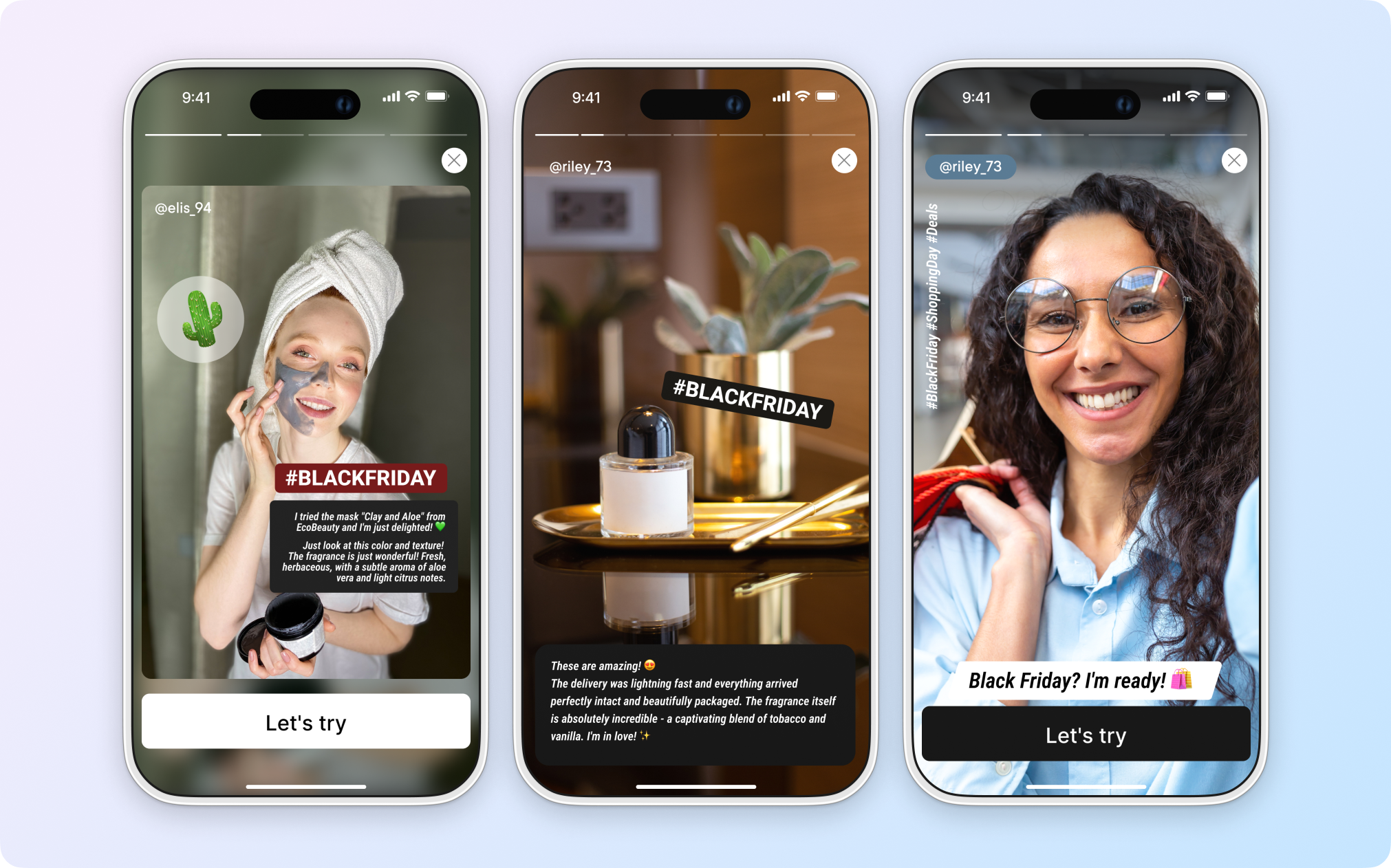
- Gamified UGC: Encourage users to share their own content directly within the app. For example, a beauty app could invite users to upload photos of their looks for a chance to be featured in a weekly “Spotlight.” This not only builds engagement but also creates a feedback loop of fresh content.
However, the challenge is curating this content thoughtfully. Irrelevant or low-quality UGC can do more harm than good.
Pro: Builds trust and adds authenticity to your brand.
Con: Requires careful moderation to ensure relevance and quality.
Strategy 10. Mobile App Personalization
Mobile apps offer unique opportunities for deep personalization. Think push notifications that align with user behavior or interactive stories that highlight achievements, special offers, or exclusive content. Tools like InAppStory make it easy to incorporate personalized, gamified experiences directly into your app.
The key is balance. Overloading users with notifications or overly complex personalization can overwhelm them. Instead, focus on small, meaningful interactions.
Pro: Great for engagement and retention.
Con: Risks user fatigue if overused.
Strategy 11. Personalized, Guided Onboarding
Give users an onboarding experience that feels tailor-made, from welcoming them by name to guiding through features based on their needs. Personalized onboarding creates an instant connection, helping users engage faster and stick around longer.
Not all personalization strategies are created equal, and what works for one business might not work for another. The key is to start small and focus on areas that will have the most impact for your customers. And remember: personalization is about making the customer experience feel just a little more human.
Ethical and Responsible Personalization
Transparency with Users
When it comes to personalization in ecommerce, one thing is certain: customers want to know what’s going on behind the scenes. They’re not just random clicks on your personalized homepage or figures in your website personalization tool. They’re people with real concerns about how their data is tracked, stored, and used to deliver those personalized experiences.
According to a recent consumer privacy report by the Association of National Advertisers, 70% of surveyed consumers said they want the ability to choose exactly how their data is collected for online shopping personalization. This finding underscores a basic truth: when consumers seek to maximize their total utility, they want clarity on what they’re getting in exchange for their information.

So what does being transparent actually look like?
- Explain Why You’re Doing It: If you’re using ecommerce personalization software to recommend products based on browsing history, say so. A quick note on your product page or a concise “How We Personalize” blurb can work wonders.
- Show How It Helps Them: Are you creating a smoother personalized user experience? Are you cutting down search time with website personalisation? Spell it out.
- Offer Clear Opt-Out Choices: Some customers might be okay with an e-commerce personalization approach but still want the option to turn off targeted ads or customer personalization features. Make that setting easy to find and easy to switch.
Respect User Boundaries
Data-driven personalization strategies can feel intrusive if brands overstep. Think about the times you’ve shopped for a birthday gift, then seen that item follow you around for days. That’s the line between helpful suggestion and digital stalking.
A helpful example: Etsy. Although Etsy thrives on personalized ecommerce suggestions—especially for unique, handmade items—they let users manage personalization settings directly from their account. It’s straightforward. Want fewer targeted recommendations? One click and you’re all set. That kind of user autonomy makes people feel respected.
Here’s why respecting boundaries matters:
- Trust Is Hard to Earn, Easy to Lose: If shoppers sense you’re using data for questionable purposes, they’ll leave fast. That’s a surefire way to harm your personalized ecommerce experience and your brand.
- Compliance Is Not Optional: Regulations like GDPR or CCPA mandate certain levels of user control and consent. Providing a clear path to opt out of personalization not only builds trust but also keeps you aligned with legal requirements.
- Long-Term Loyalty: People come back to brands they trust. A respectful approach to website personalization or b2b ecommerce personalization can make the difference between a one-time visitor and a repeat customer.
In short, responsible ecommerce personalization is about treating customers like real individuals—because they are. Being upfront about what is personalization and letting them decide how much customization they’re comfortable with creates a healthier, more sustainable relationship. And that relationship is what keeps them clicking “Add to Cart” again and again.
⚡ Consumers expect personalized experiences, and zero-party data — information they willingly provide — enables brands to deliver them. By gathering data through surveys, quizzes, or personalized offers, brands can create more meaningful connections and tailor interactions based directly on customer input.

Use interactive surveys and polls to collect zero-party data directly from users. This data helps brands personalize content, offers, and products to match user preferences while maintaining trust. InAppStory is an all-in-one customer engagement platform for mobile apps focused on enhancing user experience with seamless visual in-app communication.
Future Trends and Opportunities
Contextual Personalization
Picture your customers scattered across different time zones, some waking up to frosty mornings while others relax under a blazing sun. Contextual personalization gives you a way to respond to those realities in real time. It goes beyond generic “Recommended for You” widgets. Instead, it blends specific data—like location, local climate, and even time of day—with user behavior to deliver a personalized experience that feels relevant right now.
If a shopper in Sweden checks your custom e-commerce store at 7 a.m. and there’s a snowstorm outside, it might make sense to spotlight thermal wear and cozy blankets. Meanwhile, visitors in Florida scrolling at noon could see swimwear or beach accessories. The concept sounds straightforward, but the implementation can be complex. You need robust ecommerce personalization tools that integrate data from weather APIs, shipping logistics, and browsing history without overwhelming your infrastructure.
Some marketers view this type of ecommerce personalization as the next frontier. They point to the fact that businesses harnessing advanced AI-driven analytics in contextual campaigns could see significant growth in conversion rates. That’s the optimistic take.
On the other hand, critics raise a valid concern: how comfortable are users with letting a brand know such specific details about their environment? You might win a sale by promoting the perfect umbrella on a rainy day, but you could also lose trust if customers feel you’re tracking their every step. Do you make it crystal clear how this data is collected? And do you offer a quick opt-out for those who find it intrusive?
These are tricky questions that product managers and business owners need to confront. The balance between a delightfully personalized homepage and respecting user boundaries is never a one-size-fits-all scenario. In other words, contextual website personalization can set you apart, but only if you tread carefully.
Voice Commerce and Emerging Channels
Whether you’re a B2C brand or diving into b2b ecommerce personalization, voice commerce promises to shake up how people discover and buy products. At first glance, letting shoppers place orders through a smart speaker or chatbot sounds neat. It’s hands-free, immediate, and can learn from previous purchases, leading to an almost concierge-like personalized ecommerce experience. Ask Alexa to reorder coffee pods, and it might politely suggest the creamer you bought last month. That level of convenience resonates with many busy consumers who love skipping the usual point-and-click routine.
But not everyone is on board. Voice commerce technologies still have limitations. Shoppers who like comparing dozens of products or reading detailed user reviews before buying might find it cumbersome to do so via voice. Privacy concerns also loom large. Which technology do online stores usually use to present customized content in voice channels? Typically, it’s a mix of natural language processing, AI-based user profiles, and integration with an ecommerce personalization platform.
The rub is that these systems are “always listening” for wake words, which can make some people uneasy, especially if they didn’t expect their casual kitchen banter to inform future product recommendations. Are you prepared to address these privacy questions head-on, perhaps through transparent data usage statements or explicit consent forms? Voice commerce is expanding, no doubt, but the audience it attracts may remain niche until brands figure out how to make it feel both helpful and respectful.
Customer-Led Personalization
We often imagine personalization as a background process managed by sophisticated algorithms: the system crunches user data, churns out suggestions, and voilà—our homepage or app feed looks tailor-made. There’s another angle gaining traction: let the user dictate the personalization themselves. Think of it as a “choose your own adventure” approach to online shopping personalization, where shoppers fine-tune their preferences—like specifying favorite colors, dietary restrictions, or style icons—so the store or app can adapt in real time. Instead of guessing that a new mom wants baby products, you let her say, “Hey, I’m actually looking for ergonomic strollers and organic baby clothes,” and then the personalized website experience shifts accordingly.
Some fashion and beauty brands have championed this approach, turning to quizzes, preference toggles, and interactive surveys. Stitch Fix is a famous example, where the entire model revolves around user inputs guiding stylists.
On one hand, this fosters loyalty. People enjoy feeling in control of their ecommerce personalisation journey rather than passively being targeted by an algorithm.
On the other hand, it can create friction. Not everyone wants to spend time answering a bunch of questions, especially if they’re in a hurry. It also raises another dilemma: if a user overly narrows their preferences, do they miss out on potentially interesting products?
That’s why some experts argue that successful customer personalization weaves machine insights with user-driven inputs, offering a balanced pathway. Will customers embrace this co-creation model? Or will they revert to the familiarity of a curated product feed that doesn’t require any work on their end? The answer likely depends on your audience. If they’re highly engaged shoppers craving a hands-on approach, personalized ecommerce that asks for their input can be a perfect fit. If they’re casual browsers, it might be one step too many.
Ultimately, exploring contextual triggers, voice-assisted shopping, and customer-led ecommerce customization and personalization opens new doors for brands seeking a unique edge. Yet each trend carries its own set of pros, cons, and open-ended questions. Is your team prepared to handle user-data integration in real time? How do you plan to handle the inevitable privacy pushback? Are you giving customers enough autonomy without burying them in toggles and questionnaires?
These are the the details that marketers, product managers, and business owners must navigate in the quest for a more personalized commerce environment. A truly personalized user experience might be the golden ticket to deeper loyalty and higher conversions—but only if it respects the shopper’s comfort zone and genuinely addresses their needs.
Conclusion
Personalization in ecommerce is less about bombarding people with ads and more about respecting their preferences in a way that feels natural. Whether you’re experimenting with website personalization, trying out voice commerce, or inviting customers to tailor their own personalized experience, the goal is always the same: help people find what they want without turning them into data points on a dashboard.
Of course, real customer personalization isn’t easy. It requires robust ecommerce personalization tools, a keen sense of timing, and above all, honesty about how you’re collecting and using information. If you’re transparent and give shoppers real reasons to trust you, ecommerce personalization can become a genuine advantage—not just for conversions, but for building loyalty over the long run.
Ecommerce personalization isn’t limited to desktop websites. Mobile apps open up fresh possibilities for online shopping personalization that feels direct and immediate. Whether you’re experimenting with in-app stories, homepage personalization, or well-timed discounts, the key remains the same: deliver relevant, personalized experiences while respecting the customer’s space.
In the end, it’s about balance. Offer enough customization to be helpful, but don’t smother users with so many options that they feel lost. Give them room to choose the depth of personalization they want. When it’s done right, personalized commerce can turn casual browsers into repeat customers who know you’re listening to their needs—and giving them a reason to stick around.

